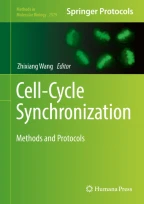BrdU Incorporation Assay to Analyze the Entry into S Phase

5-Bromo-2′-deoxyuridine (bromodeoxyuridine (BrdU)), a modified nucleotide and analog of thymidine, is commonly used for detecting proliferating cells. For detection, an anti-BrdU antibody (probe) with a fluorescent dye is applied to bind the BrdU label after DNA denaturation. In this protocol, we provide the BrdU labeling method for both in vitro and in vivo studies, along with immunocytochemistry (ICC)/immunofluorescence (IF) and immunohistochemistry (IHC) staining procedures, respectively. Multicolor staining is also presented as an option to detect the co-distribution of two or multiple antigens in the same sample, making it possible to visualize the location of different molecules at the same time.
This is a preview of subscription content, log in via an institution to check access.
Access this chapter
Subscribe and save
Springer+ Basic
€32.70 /Month
- Get 10 units per month
- Download Article/Chapter or eBook
- 1 Unit = 1 Article or 1 Chapter
- Cancel anytime
Buy Now
Price includes VAT (France)
eBook EUR 93.08 Price includes VAT (France)
Softcover Book EUR 116.04 Price includes VAT (France)
Hardcover Book EUR 158.24 Price includes VAT (France)
Tax calculation will be finalised at checkout
Purchases are for personal use only
Similar content being viewed by others

Cell Cycle Analysis Using In Vivo Staining of DNA-Synthesizing Cells
Chapter © 2020

Analysis of Cell Proliferation and Homeostasis Using EdU Labeling
Chapter © 2016
A novel multicolor immunostaining method using ethynyl deoxyuridine for analysis of in situ immunoproliferative response
Article Open access 15 May 2015
References
- Dictionary M. Tritiated thymidine. [Cited 2021]. Available from: https://medical-dictionary.thefreedictionary.com/tritiated+thymidine
- Duque A, Rakic P (2011) Different effects of bromodeoxyuridine and [3H]thymidine incorporation into DNA on cell proliferation, position, and fate. J Neurosci 31(42):15205–15217 ArticleCASGoogle Scholar
- Sugihara H, Hattori T, Fukuda M (1986) Immunohistochemical detection of bromodeoxyuridine in formalin-fixed tissues. Histochemistry 85:193–195 ArticleCASGoogle Scholar
- Rosenstein JM, Krum JM (1994) 2 – Models of angiogenesis and the blood–brain barrier. In: Flanagan TR, Emerich DF, Winn SR (eds) Methods in neurosciences. Academic Press, San Diego, California, pp 20–32 Google Scholar
- Cawood AH, Savage JRK (1983) A comparison of the use of bromodeoxyuridine and [3H]thymidine in studies of the cell cycle. Cell Tissue Kinet 16:51–57 CASPubMedGoogle Scholar
- Matatall KA, Kadmon CS, King KY (2018) Detecting hematopoietic stem cell proliferation using BrdU incorporation. Methods Mol Biol 1686:91–103 ArticleCASGoogle Scholar
- Dickendesher TL, Duan Y, Giger RJ (2013) Axon regeneration. In: Cellular migration and formation of neuronal connections, pp 151–175 Google Scholar
- Gerdes J, Lemke H, Baisch H, Wacker HH, Schwab U, Stein H (1984) Cell cycle analysis of a cell proliferation-associated human nuclear antigen defined by the monoclonal antibody Ki-67. J Immunol 133(4):1710–1715 CASPubMedGoogle Scholar
- Pennock S, Wang Z (2003) Stimulation of cell proliferation by endosomal epidermal growth factor receptor as revealed through two distinct phases of signaling. Mol Cell Biol 23(16):5803–5815 ArticleCASGoogle Scholar
- Abcam. Immunohistochemistry (IHC): the complete guide. [Cited 14 Oct 2021]. Available from: https://www.abcam.com/content/immunohistochemistry-the-complete-guide
- Shi SR et al (1996) Use of pH 9.5 Tris-HCl buffer containing 5% urea for antigen retrieval immunohistochemistry. Biotech Histochem 71(4):190–196 ArticleCASGoogle Scholar
- Wojtowicz JM, Kee N (2006) BrdU assay for neurogenesis in rodents. Nat Protoc 1(3):1399–1405 ArticleCASGoogle Scholar
- Abcam. IHC antigen retrieval protocol. [Cited 14 Oct 2021]. Available from: https://www.abcam.com/protocols/ihc-antigen-retrieval-protocol
- Abcam. Anti-BrdU antibody [BU1/75 (ICR1)] – Proliferation Marker (ab6326). [Cited 19 Oct 2021]. Available from: https://www.abcam.com/brdu-antibody-bu175-icr1-proliferation-marker-ab6326.html
- Abcam. BrdU (5-bromo-2’-deoxyuridine), Thymidine analog (ab142567). [Cited 18 July 2022]. Available from: https://www.abcam.com/brdu-5-bromo-2-deoxyuridine-thymidine-analog-ab142567.html?productWallTab=ShowAll
- Karlsen OA, Berven FS, Jensen HB, Fjellbirkeland A (2011) Chapter eleven - Methanotroph Outer Membrane Preparation. Methods in Enzymology, Academic Press, 495, pp 167–176. Available from: https://doi.org/10.1016/B978-0-12-386905-0.00011-5
- Jamur MC, Oliver C (2010) Permeabilization of cell membranes. Methods Mol Biol 588:63–66. https://doi.org/10.1007/978-1-59745-324-0_9. PMID: 20012820
- Abcam. BrdU staining and BrdU assay protocol. [Cited 18 July 2022] Available from: https://www.abcam.com/protocols/brdu-staining-protocol
- Abcam. IHC-PARAFFIN PROTOCOL (IHC-P). [Cited 18 July 2022] Available from: https://www.abcam.com/ps/pdf/protocols/ihc_p.pdf
- Abcam. Immunocytochemistry and immunofluorescence staining protocol. [Cited 18 Oct 2021]. Available from: https://www.abcam.com/protocols/immunocytochemistry-immunofluorescence-protocol
- Abcam. IHC staining protocol for paraffin, frozen, and free floating sections. [Cited 18 Oct 2021]. Available from: https://www.abcam.com/protocols/immunostaining-paraffin-frozen-free-floating-protocol
- Abcam. ab228549 – DAPI staining solution. [Cited 18 Oct 2021]. Available from: https://www.abcam.com/ps/products/228/ab228549/documents/DAPI-Staining-protocol-book-v2-ab228549%20(website).pdf
- ThermoFisher. Hoechst 33342 solution (20 mM). [Cited 19 Oct 2021]. Available from: https://www.thermofisher.com/order/catalog/product/62249
- Abcam. Indirect flow cytometry protocol. [Cited 19 Oct 2021]. Available from: https://www.abcam.com/protocols/indirect-flow-cytometry-protocol
- Crane AM, Bhattacharya SK (2013) The use of bromodeoxyuridine incorporation assays to assess corneal stem cell proliferation. Methods Mol Biol 1014:65–70 ArticleCASGoogle Scholar
- Fatemah Chehrehasa ACBM, Dwyer P, Abrahamsen G, Mackay-Sim A (2009) EdU, a new thymidine analogue for labelling proliferating cells in the nervous system. J Neurosci Methods 177(1):122–130 ArticleGoogle Scholar
Acknowledgments
This work was supported by Atomic Energy of Canada Limited’s Federal Nuclear Science & Technology Program and CANDU Owners Groups (COG) Strategic Research and Development (SRD) program.
Author information
Authors and Affiliations
- Radiobiology and Health, Canadian Nuclear Laboratories, Chalk River, ON, Canada Jihang Yu & Yi Wang
- Department of Medical Genetics, University of Alberta, Edmonton, AB, Canada Zhixiang Wang
- Department of Biochemistry, Microbiology and Immunology, University of Ottawa, Ottawa, ON, Canada Yi Wang
- Jihang Yu

